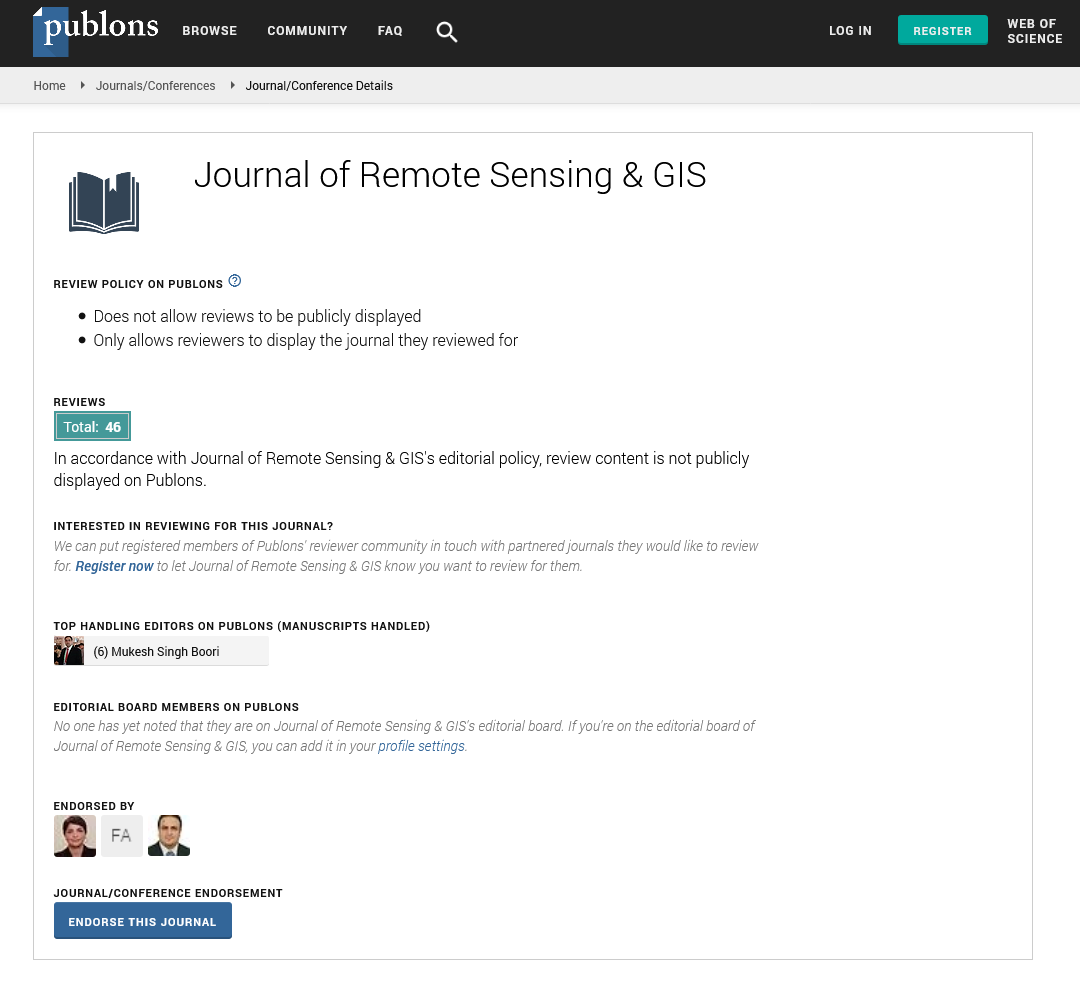Indexed In
- Open J Gate
- RefSeek
- Hamdard University
- EBSCO A-Z
- OCLC- WorldCat
- Publons
- International Scientific Indexing
- Euro Pub
- Google Scholar
Useful Links
Share This Page
Journal Flyer

Open Access Journals
- Agri and Aquaculture
- Biochemistry
- Bioinformatics & Systems Biology
- Business & Management
- Chemistry
- Clinical Sciences
- Engineering
- Food & Nutrition
- General Science
- Genetics & Molecular Biology
- Immunology & Microbiology
- Medical Sciences
- Neuroscience & Psychology
- Nursing & Health Care
- Pharmaceutical Sciences
Commentary - (2022) Volume 11, Issue 9
Analysis of Land Surface Using Remote Sensing Technology
Catherine Willi*Received: 02-Sep-2022, Manuscript No. JGRS-22-18432; Editor assigned: 05-Sep-2022, Pre QC No. JGRS-22-18432 (PQ); Reviewed: 20-Sep-2022, QC No. JGRS-22-18432; Revised: 26-Sep-2022, Manuscript No. JGRS-22-18432 (R); Published: 04-Oct-2022, DOI: 10.35248/2469-4134.22.11.255
Description
Land is a delineable area, encompassing all the attributes of the biosphere immediately above or below the earth surface, including the soil, terrain surface hydrology, the near-surface climate, sediments and associated groundwater reserve, the biological resources, as well as human settlement pattern and infrastructure resulting from human activity FAO, 1992. Over 70 percent of the energy absorbed into the climate system is absorbed by the surface which underlies the importance of the surface hydrology for the climate system. The exchange of energy between atmosphere and land surface depends on the characteristics of the land cover, as described in FAO definition of land. Therefore land characterization is one of the important inputs for weather/climate or environmental analysis. Remote sensing has promised to revolutionize land characterization by delivering spatial critical information of land surface. Numerous airborne and space-based sensors using multi-angle, multispectral and radar techniques have been used to demonstrate the efficiency of a remote sensing/GIS approach to land characterization and management.
Remote Sensing is defined as the science and technology by which the characteristics of objects of interest can be identified, measured or analysed without direct contact with the object. Electro-magnetic radiation that is reflected or emitted from an object is the usual source of remote sensing data. The remote sensing data will be processed automatically by computer and/or manually interpreted by humans, and finally utilized in agriculture, land use, forestry, geology, hydrology, oceanography, meteorology, environment etc.
The multi-temporal data analysis is essential for the characterization of land that is changing its surface properties from season to season. Hence, the pre-requisite data should be available in summer, winter and monsoon seasons. However, during cloudy sky condition, the availability of optical data is a problem. Hence, use of microwave remote sensing technique is a better option. Microwave remote sensing, using microwave wavelengths from about one centimeter to a few tens of centimetres, enables observation in all weather conditions without any restriction by cloud or rain.
There are two types of microwave remote sensing; active and passive. The active technique employs its own source of illumination and receives the backscatter signal which is reflected from the ground surface. Synthetic Aperture Radar (SAR), microwave scatterometers, radar altimeters etc. are active microwave sensors. The spatial resolution, of the order of few meters for SAR is much higher compared to scatterometer that is having spatial resolution of the order of few kilometres. However, microwave scatterometer has edge over SAR for the regional land characterization due to its higher revisit capability that increases the number of image acquisition over a specified time interval.
Conclusion
Scatterometers measure geophysical variables related to the earth's water cycle, including precipitation rate, cloud water, water vapour, sea surface winds, sea surface temperature, sea ice concentration, snow water equivalent and soil moisture. Scatterometers are unique in their ability to determine wind velocity and wind direction over Ocean surfaces. Over the land surface, backscatter is related to surface roughness and dielectric properties as well as volume scattering from vegetation and snow cover. Due to such scattering mechanism, it is possible to address some of the large-scale phenomena over the land surface as biophysical variables retrieval. In addition, it is feasible to address the problems related to snow hydrology and soil thawing.
Citation: Willi C (2022) Analysis of Land Surface Using Remote Sensing Technology. J Remote Sens GIS. 11:255.
Copyright: © 2022 Willi C. This is an open-access article distributed under the terms of the Creative Commons Attribution License, which permits unrestricted use, distribution, and reproduction in any medium, provided the original author and source are credited.

